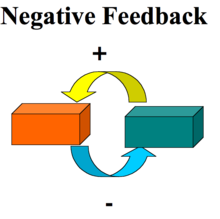One of the wisest things my introductory biology teacher ever said to us was “The body always has one foot on the gas pedal and one foot on the brake.” I think of this statement a lot when I am frustrated by the great complexity of methods that the body uses to regulate its systems. Why not just an on/off button?
Because the body is both a control freak and highly democratic. The body wants to be able to manage all the hormonal systems at a very fine level. But it doesn’t tend to manage at a central level; instead, it manages by taking votes from all the different processes participating in a system. So instead of determining that the car needs to go a particular speed and pushing down the gas pedal until that speed is reached, the body lets individual processes all have a go at hitting the gas pedal and the brake, all at the same time. One process hits the gas a few times and ramps up the car’s speed, another hits the brake and slows it back down, a couple few more do the same thing, and eventually the car is going at the speed it needs to go. That’s what my teacher meant about the gas pedal and brake at the same time. Complicated, but it’s how the body keeps control of things.
 |
| "Drawing Hands," M.C. Escher. Source: Wikipedia |
One arm of the stress system, known as the HPA axis, is a great example of this. I’ll go into the HPA axis in a lot more detail in later posts, but for now the important point is that there are several different hormones that get sent out in response to a stressful situation. One hormone triggers the release of another hormone which triggers the release of another hormone. It’s sort of like a game of dominoes, where you push the first domino and it causes the next ones to fall, in a self-propagating line.
.png/640px-HPA_Axis_Diagram_(Brian_M_Sweis_2012).png) |
| "HPA Axis Diagram (Brian M Sweis 2012)" by BrianMSweis - Own work. Licensed under CC BY-SA 3.0 via Wikimedia Commons |
The body sets things up this way because, unlike with a line of dominoes, each new step in the hormone cascade can boost or decrease the volume of the message. So the brain releases the first hormone, CRH, and it filters into another part of the brain, which says, “I see hormone #1! Time to release hormone #2!” This part of the brain can then decide to release a lot of hormone #2 or a little of hormone #2, making the message louder or softer. Hormone #2, ACTH, goes out to the adrenal glands, and they release hormone #3, CORT — again with a chance to boost (or muffle) the signal. By the end of the cascade, the message may have been amped way up (high levels of CORT in the blood), or it may have petered out (low levels of CORT in the blood), depending on whether the gas pedal got pushed more or the brake got pushed more.
This cascade system suggests that hormones farther down in the cascade are powerless over their own fates. But in fact they do get a chance to feed back into the system. Just like students who are asked at the end of a course for their feedback on their professor’s performance, hormones at the bottom of a cascade often provide information which is then used back at the top of a cascade.
In the case of the stress system, the brain sends out CRH, in other words, the message “release more stress hormones,” in response to a stressful event. This message goes through several levels at which it could be amplified or muffled, so the brain needs a way to know whether to keep pushing the gas pedal by sending the message “more stress hormones! That’s nowhere near enough for this situation!” or decide that the message has been sent sufficiently and hit the brake. The brain does this by monitoring the levels in the blood of CORT, the final hormone in the cascade. If the brain sees more of this bottom-level hormone, it releases less of the top regulatory hormone, which allows the system to settle down. If it sees less, it releases more of the top regulatory hormone, keeping the system ramped up. This is called a negative feedback loop: higher levels in later parts of the system result in lower levels in the earlier parts of the system. What goes up must come down — systems that have negative feedback loops are characterized by an initial increase in response to a stimulus (an increase in stress hormone levels in response to a stressful event) followed by gradual reduction (the levels of stress hormones gradually decrease as time passes after the stressful event).
 |
| Source: wikimedia.org |
A few systems have positive feedback loops, in which increased levels of hormones lower in the cascade lead to increased, not decreased, levels of hormones higher in the cascade. The only hormonal example of a positive feedback loop that I know of (though I imagine there are more) occurs during birth, when hormones which lead to uterine contractions cause more of the same hormones to be released. This particular positive feedback loop is halted by the completion of the birth process.
 | |
| Cattle? Hormones? Both have positive feedback loops. Source: Wikipedia |
The consequence of having such a complex regulation process for managing hormone levels is that there are a lot of places for things to go wrong. For veterinarians trying to diagnose endocrine diseases (diseases relating to hormone imbalances), this means a lot of tests often have to be run to find the root of a particular hormone problem. From my perspective as someone who’s trying to figure out how the stress system behaves differently in fearful dogs, this means there is rarely or never a clear answer to questions I want to ask. CORT levels might be higher in one dog compared to another, less fearful dog. But why — because of what point in the cascade? Or because of the process that triggers the cascade in the first place? Or because of some side process influencing the cascade (the passenger who reaches over and grabs the hand brake while you’re driving)?
It is useful to try understand hormonal processes, but we have to remember that we’re understanding them only at a very high, abstracted level. Inside a real dog’s body, there are a zillion little processes interacting in ways we can’t ever see or completely understand. Meaningful understanding of these processes isn’t impossible, but complete understanding might be!